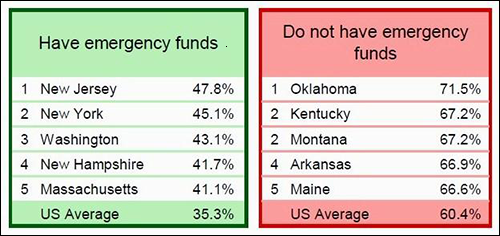By Pam Martens: December 21, 2012
The Financial Industry Regulatory Authority (FINRA), the self regulatory body that oversees Wall Street firms, has an Investor Education Foundation whose aim is to boost financial literacy and warn folks about investment scams.
Earlier this year, FINRA put out an advisory titled: “Weathering Tough Economic Times – 12 Tips for 2012.” I have to take serious issue with one of their recommendations.
Tip number one from FINRA is to set up a rainy day fund: “Set aside at least one month of your current salary (and work your way up to three months) in a federally insured savings account. This will give you a cushion to handle medical bills, a short job loss, a surprise car repair or other financial emergency – and help keep your finances under control.”
A backup savings account that will last for three months is more like a brief shower fund than a rainy day fund. It’s certainly not adequate for the kind of Perfect Storm the economy is currently witnessing.
Data for November 2012 released by the Bureau of Labor Statistics shows that the average length of unemployment was 40.1 weeks, down just slightly from the 41.1 weeks registered in November 2011.
The personality of the individual seeking work, his or her age, and whether that industry is hiring or downsizing can also impact the duration of unemployment. A single individual obviously needs a rainy day fund to cover a longer period than a two-wage household where it is less likely that both would be unemployed at the same time. A household with hefty monthly mortgage payments needs a heftier fund than a household with no mortgage.
In short, there is no one-size-fits-all formula for how many months of salary one should have in an emergency account but using the average duration of unemployment, 40 weeks or 10 months, is a much safer benchmark than the 3 months recommended by FINRA. A fund that covers an even longer period may be more prudent for those with a large family of underage children.
In a study released on February 26, 2010 for the Financial Crisis Inquiry Commission, Annamaria Lusardi together with Dartmouth College and the National Bureau of Economic Research made the following findings:
-
Nearly one-quarter (23 percent) of individuals with checking accounts reported overdrawing those accounts on occasion. Significantly, of those who overdrew their accounts, 73 percent reported finding it very or somewhat difficult to cover their monthly expenses and pay their bills.
-
About 16 percent of mortgage borrowers reported having been late on a payment at least once in the last 2 years, including 10 percent who had been late more than once.
-
A smaller but significant number of respondents who have self-directed retirement accounts (either an employer-sponsored defined contribution plan or a retirement account they manage on their own) reported tapping into their retirement savings. Specifically, nearly 9 percent have taken out a loan from their retirement accounts during the past 12 months, and almost 5 percent have taken a permanent hardship withdrawal. These depletions are most prevalent among those earning between $25,000 and $75,000 a year, with more than 10 percent of this income cohort borrowing against their retirement savings and nearly 8 percent taking hardship withdrawals.
-
The recent economic crisis has hit individuals hard, hindering their ability to make ends meet. One-third of respondents stated they had experienced a large and unexpected drop in income during the past year. Workers earning less than $25,000 a year and Hispanics appear to have been especially hard hit, with 41 percent and 43 percent, respectively, reporting a drop in income. Across all demographic groups, those who suffered large decreases in income were more likely to report having difficulties covering their expenses.
The study noted that its findings were consistent with the results from the Global Economic Crisis survey. Americans were asked how confident they were that they could come up with $2,000 if an unexpected emergency arose within the next month. As many as 46 percent of Americans stated they cannot or are not confident they could come up with $2,000 in a month’s time.
In 2010, FINRA released a state-by-state study measuring various metrics on financial capability, including rainy day funds. States showing the most individuals with rainy day funds were New Jersey, New York, Washington, New Hampshire and Massachusetts. Those states ranking at the bottom were Oklahoma, Kentucky, Montana, Arkansas and Maine.
————-
Pam Martens, Editor of Wall Street On Parade, managed the life savings of average Americans for 21 years on Wall Street. Her personal finance columns seek to help the public better understand the jargon, complexities, and conflicts of Wall Street. The information that appears on this site cannot, and does not, take into account your particular investment goals, your unique financial situation or income needs and is not intended to be recommendations appropriate for you. When it comes to making your own investment decisions, you should always consult in advance with your financial advisor and accountant.
At times, Wall Street On Parade links to news or opinion on other sites which we believe to be in the public interest. These web sites may also contain investment advice or investment advertising. We receive no remuneration for these links, provide them purely in the public interest, and are not endorsing or recommending any investment information that may appear on the site.


